*NURSING > HESI > 2022 HESI EXIT RN EXAM V1-V4 with CORRECT ANSWERS AND RATIONALE 2022 HESI EXIT RN EXAM (All)
2022 HESI EXIT RN EXAM V1-V4 with CORRECT ANSWERS AND RATIONALE 2022 HESI EXIT RN EXAM
Document Content and Description Below
36. The client with which type of wound is most likely to need immediate intervention by the nurse? • Laceration • Abrasion • Contusion • Ulceration • Rationale: A laceration is a woun... d that is produced by the tearing of soft body tissue. This type of wound is often irregular and jagged. A laceration wound is often contaminated with bacteria and debris from whatever object caused the cut. 37. The nurse is planning care for a client admitted with a diagnosis of pheochromocytoma. Which intervention has the highest priority for inclusion in this client’s plan of care? • Monitor blood pressure frequently • Rationale: A pheochromocytoma is a rare, catecholamine-secreting tumor that may precipitate life-threatening hypertension. The tumor is malignant in 10% of cases but may be cured completely by surgical removal. Although pheochromocytoma has classically been associated with 3 syndromes—von Hippel-Lindau (VHL) syndrome, multiple endocrine neoplasia type 2 (MEN 2), and neurofibromatosis type 1 (NF1)—there are now 10 genes that have been identified as sites of mutations leading to pheochromocytoma. 38. When caring for a client who has acute respiratory distress syndrome (ARDS), the nurse elevates the head of the bed 30 degrees. What is the reason for this intervention? • To reduce abdominal pressure on the diaphragm • to promote retraction of the intercostal accessory muscle of respiration • to promote bronchodilation and effective airway clearance • to decrease pressure on the medullary center which stimulates breathing • Rationale: a semi-sitting position is the best position for matching ventilation and perfusion and for decreasing abdominal pressure on the diaphragm, so that the client can maximize breathing. 39. When assessing a mildly obese 35-year-old female client, the nurse is unable to locate the gallbladder when palpating below the liver margin at the lateral border of the rectus abdominal muscle. What is the most likely explanation for failure to locate the gallbladder by palpation? • The client is too obese • Palpating in the wrong abdominal quadrant • Deeper palpation technique is needed• The gallbladder is normal • Rationale: a normal healthy gallbladder is not palpable 40. A woman with an anxiety disorder calls her obstetrician’s office and tells the nurse of increased anxiety since the normal vaginal delivery of her son three weeks ago. Since she is breastfeeding, she stopped taking her antianxiety medications, but thinks she may need to start taking them again because of her increased anxiety. What response is best for the nurse to provide this woman? • describe the transmission of drugs to the infant through breast milk • encourage her to use stress relieving alternatives, such as deep breathing exercises • Inform her that some antianxiety medications are safe to take while breastfeeding • Explain that anxiety is a normal response for the mother of a 3-week-old. • Rationale: there are several antianxiety medications that are not contraindicated for breastfeeding mothers. 41. An older male client with a history of type 1 diabetes has not felt well the past few days and arrives at the clinic with abdominal cramping and vomiting. He is lethargic, moderately, confused, and cannot remember when he took his last dose of insulin or ate last. What action should the nurse implement first? • Start an intravenous (IV) infusion of normal saline • obtain a serum potassium level • administer the client's usual dose of insulin • assess pupillary response to light • Rationale: the nurse should first start an intravenous infusion of normal saline to replace the fluids and electrolytes because the client has been vomiting, and it is unclear when he last ate or took insulin. The symptoms of confusion, lethargy, vomiting, and abdominal cramping are all suggestive of hyperglycemia, which also contributes to diuresis and fluid electrolyte imbalance. 42. A client who received multiple antihypertensive medications experiences syncope due to a drop in blood pressure to 70/40. What is the rationale for the nurse’s decision to hold the client’s scheduled antihypertensive medication? • increased urinary clearance of the multiple medications has produced diuresis and lowered the blood pressure • the antagonistic interaction among the various blood pressure medications has reduced their effectiveness • The additive effect of multiple medications has caused the blood pressure to drop too low • the synergistic effect of the multiple medications has resulted in drug toxicity and resulting hypotension 43. Which client is at the greatest risk for developing delirium? • An adult client who cannot sleep due to constant pain. • an older client who attempted 1 month ago • a young adult who takes antipsychotic medications twice a day • a middle-aged woman who uses a tank for supplemental oxygen 44. Which intervention should the nurse include in a long-term plan of care for a client withChronic Obstructive Pulmonary Disease (COPD)? • Reduce risks factors for infection • Administer high flow oxygen d 63. The nurse should teach the parents of a 6 year-old recently diagnosed with asthma that the symptom of acute episode of asthma are due to which physiological response? • Inflammation of the mucous membrane & bronchospasm 64. A 10 year old who has terminal brain cancer asks the nurse, "What will happen to my body when I die?" How should the nurse respond? • "The heart will stop beating & you will stop breathing." 65. The nurse is assessing a 3-month-old infant who had a pylorotomy yesterday. This child should be medicated for pain based on which findings? Select all that apply: • Restlessness • Clenched Fist • Increased pulse rate • Increased respiratory rate. • Increased temperature • Peripheral pallor of the skin 66. The nurse is preparing to administer an oral antibiotic to a client with unilateral weakness, ptosis, mouth drooping and, aspiration pneumonia. What is the priority nursing assessment that should be done before administering this medication? • Determine which side of the body is weak. 67. The nurse who is working on a surgical unit receives change of shift report on a group of clients for the upcoming shift. A client with which condition requires the most immediate attention by the nurse? • Gunshot wound three hours ago with dark drainage of 2 cm noted on the dressing. • Mastectomy 2 days ago with 50 ml bloody drainage noted in the Jackson-pratt drain. • Collapsed lung after a fall 8h ago with 100 ml blood in the chest tube collection container • Abdominal-perineal resection 2 days ago with no drainage on dressing who has fever and chills. • Rationale: the client with an abdominal- perineal resection is at risk for peritonitis and needs to be immediately assessed for other signs and symptoms for sepsis. 68. The nurse is caring for a client who had gastric bypass surgery yesterday. Which intervention is most important for the nurse to implement during the first 24 postoperative hours? • Measure hourly urinary output. • Rationale: a serious early complications of gastric bypass surgery is an anastomoses leak, often resulting in death. 69. When preparing to discharge a male client who has been hospitalized for an adrenal crisis, the client expresses concern about having another crisis. He tells the nurse that he wants to stay in the hospital a few more days. Which intervention should the nurse implement? • Schedule an appointment for an out-patient psychosocial assessment. 70. An adult female client tells the nurse that though she is afraid her abusive boyfriend might one day kill her, she keeps hoping that he will change. What action should thenurse take first? • Explore client’s readiness to discuss the situation. 71. In caring for a client with Cushing syndrome, which serum laboratory value is most important for the nurse to monitor? • Lactate • Glucose • Hemoglobin • Creatinine 72. Azithromycin is prescribed for an adolescent female who has lower lobe pneumonia and recurrent chlamydia. What information is most important for the nurse to provide to this client? • Use two forms of contraception while taking this drug. 73. A client in the emergency center demonstrates rapid speech, flight of ideas, and reports sleeping only three hours during the past 48h. Based on these finding, it is most important for the nurse to review the laboratory value for which medication? • Divalproex. • Rationale: divalproex is the first line of treatment for bipolar disorder BPD because it has a high therapeutic index, few side effects, and a rapid onset in controlling symptoms and preventing recurrent episodes of mania and depression. The serum value of divalproex should be determined since the client is exhibiting symptoms of mania, which may indicate non-compliance with the medication regimen. 74. A male client who is admitted to the mental health unit for treatment of bipolar disorder has a slightly slurred speech pattern and an unsteady gait. Which assessment finding is most important for the nurse to report to the healthcare provider? • Serum lithium level of 1.6 mEq/L or mmol/l (SI) • Rationale: The therapeutic level of Serum lithium is 0.8 to 1.5 mEq/L or mmol/l (SI). Slurred speech and ataxia are sign of lithium toxicity. 75. A client was admitted to the cardiac observation unit 2 hours ago complaining of chest pain. On admission, the client’s EKG showed bradycardia, ST depression, but no ventricular ectopy. The client suddenly reports a sharp increase in pain, telling the nurse, “I feel like an elephant just stepped on my chest” The EKG now shows Q waves and ST segment elevations in the anterior leads. What intervention should the nurse perform? • Administer prescribed morphine sulfate IV and provide oxygen at 2 L/min per nasal cannula. 76. The nurse is developing a teaching program for the community. What population characteristic is most influential when choosing strategies for implementing a teaching plan? • Literacy level 77. A client is being discharged with a prescription for warfarin (Coumadin). What instruction should the nurse provide this client regarding diet? • Eat approximated the same amount of leafy green vegetables daily so the amount of vitamin K consumed is consistent. 78. A client who had a small bowel resection acquired methicillin resistant staphylococcus aureus (MRSA) while hospitalized. He treated and released, but is readmitted todaybecause of diarrhea and dehydration. It is most important for the nurse to implement which intervention. • Maintain contact transmission p the last two hours. What pathophysiological reason supports the nurse’s decision to report this finding to the healthcare provider? • Oliguria signals tubular necrosis related to hypoperfusion 100. A nurse-manager is preparing the curricula for a class for charge nurses. A staffing formula based on what data ensures quality client care and is most cost-effective? • Skills of staff and client acuity 101. When performing postural drainage on a client with Chronic Obstructive Pulmonary Disease (COPD), which approach should the nurse use? • Explain that the client may be placed in five positions 102. A client presents in the emergency room with right-sided facial asymmetry. The nurse asks the client to perform a series of movements that require use of the facial muscles. What symptoms suggest that the client has most likely experience a Bell’s palsy rather than a stroke? • Inability to close the affected eye, raise brow, or smile 103. The nurse is teaching a client how to perform colostomy irrigations. When observing the client’s return demonstration, which action indicated that the client understood the teaching? • Keeps the irrigating container less than 18 inches above the stoma 104. The nurse should teach the client to observe which precaution while taking dronedarone? • Avoid grapefruits and its juice 105. A client who sustained a head injury following an automobile collision is admitted to the hospital. The nurse include the client’s risk for developing increased intracranial pressure (ICP) in the plan of care. Which signs indicate to the nurse that ICP has increased? • Increased Glasgow coma scale score. • Nuchal rigidity and papilledema. • Confusion and papilledema • Periorbital ecchymosis. • Rationale: papilledema is always an indicator of increased ICP, and confusion is usually the first sign of increased ICP. Other options do not necessarily reflectincreased ICP. 106. The nurse is caring for a client receiving continuous IV fluids through a single lumen central venous catheter (CVC). Based on the CVC care bundle, which action should be completed daily to reduce the risk for infection? • Confirm the necessity for continued use of the CVC. 107. During an annual physical examination, an older woman’s fasting blood sugar (FBS) is determined to be 140 mg/dl or 7.8 mmol/L (SI). Which additional finding obtained during a follow-up visit 2 weeks later is most indicative that the client has diabetes mellitus (DM)? • Repeated fasting blood sugar (FBS) is 132 mg/dl or 7.4 mmol/L (SI). 108. A new mother tells the nurse that she is unsure if she will be able to transition into parenthood. What action should the nurse take? • Determine if she can ask for support from family, friend, or the baby’s father. 109. A client who was admitted yesterday with severe dehydration is complaining of pain a 24 gauge IV with normal saline is infusing at a rate of 150 ml/hour. Which intervention should the nurse implement first? • Stop the normal saline infusion. 110. An elderly female is admitted because of a change in her level of sensorium. During the evening shift, the client attempts to get out bed and falls, breaking her left hip. Buck’s skin traction is applied to the left leg while waiting for surgery. Which intervention is most important for the nurse to include in this client’s plan care? • Ensure proper alignment of the leg in traction. 111. An Unna boot is applied to a client with a venous stasis ulcer. One week later, when the Unna boot is removed during a follow-up appointment, the nurse observes that the ulcer site contains bright red tissue. What action should the nurse take in response to this finding? • Document the ongoing wound healing. 112. At the end of a preoperative teaching session on pain management techniques, a client starts to cry and states, “I just know I can’t handle all the pain.” What is the priority nursing diagnosis for this client? • Anxiety 113. The nurse note a visible prolapse of the umbilical cord after a client experiences spontaneous rupture of the membranes during labor. What intervention should the nurse implement immediately? • Elevate the presenting part off the cord. 114. A client who had a right hip replacement 3 day ago is pale has diminished breath sound over the left lower lung fields, a temperature of 100.2 F, and an oxygen saturation rate of 90%. The client is scheduled to be transferred to a skilled nursing facility (SNF) tomorrow for rehabilitative critical pathway. Based on the client’s symptoms, what recommendation should the nurse give the healthcare provider? • Reassess readiness for SNF transfer. 115. A client who is newly diagnosed with type 2 diabetes mellitus (DM) receives a prescription for metformin (Glucophage) 500 mg PO twice daily. What information should the nurse include in this client’s teaching plan? (Select all that apply.) • Recognize signs and symptoms of hypoglycemia. • Report persist polyuria to the healthcare provider.• Take Glucophage with the morning and evening meal. 116. The nurse is developing an educational program for older clients who are being discharged with new antihypertensive medications. The nurse should ensure that the educational materials include which characteristics? Select all that apply • Written at a twelfth grade reading level • Contains a list with definitions of unfamiliar terms • Uses common words with few Syllables • Printed using a 12 point type font • Uses pictures to help illustrate complex ideas • Rationale: During the aging process older clients often experience sensory or cognitive changes, such as decreased visual or hearing acuity, slower thought or reasoning processes, and shorter attention span. Materials for this age group should include at least of terms, such as a medical terminology that incline may not know and use common words that expresses information clearly and simply. Simple, attractive pictures help hold the learner’s attention. The reading level of material should be at the 4th to 5th grade level. Materials should be printed using large font (18-point or higher), not the standard 12-point font. 117. During the admission assessment, the nurse auscultates heart sounds for a client with no history of cardiovascular disease. Where should the nurse listen when assessing the client’s point of maximal impulse (PMI) (Click the chosen location. To change, click on a new location) • 118. An older male adult resident of long-term care facility is hospitalized for a cardiac catheterization that occurred yesterday. Since the procedure was conducted, the client has become increasingly disoriented. The night shift nurse reports that he attempted to remove the sandbag from his femoral artery multiple times during the night. What actions should the nurse take? (Select all that apply.) • Notify the healthcare provider of the client’s change in mental status. • Include q2 hour’s reorientation in the client’s plan of care. 119. An older male comes to the clinic with a family member. When the nurse attempts to take the client’s health history, he does not respond to questions in a clearmanner. What action should the nurse implement first? • Assess the surroundings for noise and distractions. 120. The nurse caring for a client with acute renal fluid (ARF) has noted that the client has voided 800 ml of urine in 4 hours. Based on this assessment, what should the nurse anticipate that client will need? • Large amounts of fluid and electrolyte replacement. 121. Which intervention should the nurse include in the plan of care for a child with tetanus? • Minimize the amount of stimuli in the room 122. Suicide precautions are initiated for a child admitted to the mental health unit following an intentional narcotic overdose. After a visitor leaves, the nurse finds a package of cigarettes in the client’s room. Which intervention is most important for the nurse to implement? • Remove cigarettes for the client’s room 123. A family member of a frail elderly adult asks the nurse about eligibility requirements for hospice care. What information should the nurse provide? (Select all that apply.) • A client must be willing to accept palliative care, not curative care. • The healthcare provider must project that the client has 6 months or less to live. 124. A client with atrial fibrillation receives a new prescription for dabigatran. What instruction should the nurse include in this client’s teaching plan? [Show More]
Last updated: 1 year ago
Preview 1 out of 179 pages
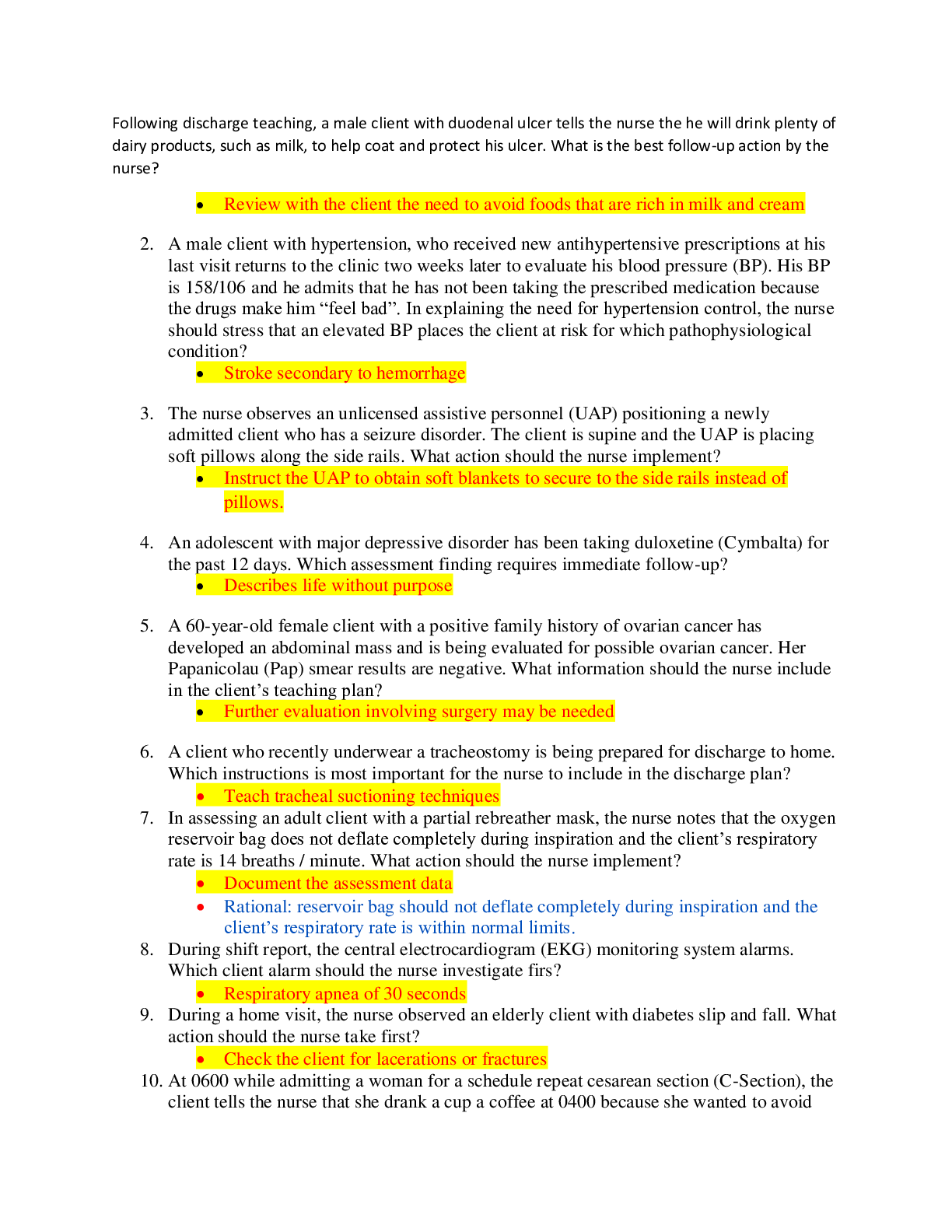
Reviews( 0 )
Document information
Connected school, study & course
About the document
Uploaded On
Aug 21, 2020
Number of pages
179
Written in
Additional information
This document has been written for:
Uploaded
Aug 21, 2020
Downloads
2
Views
309


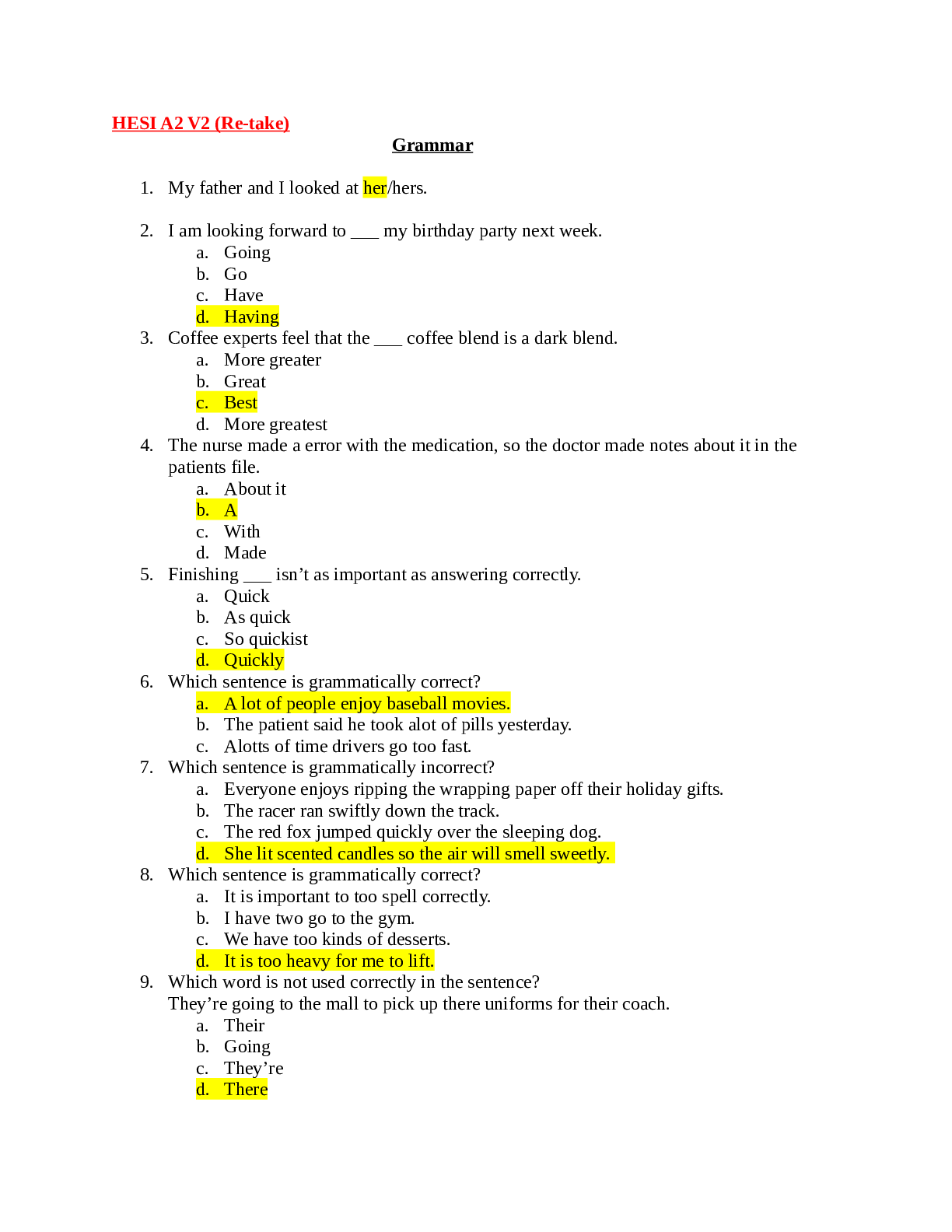

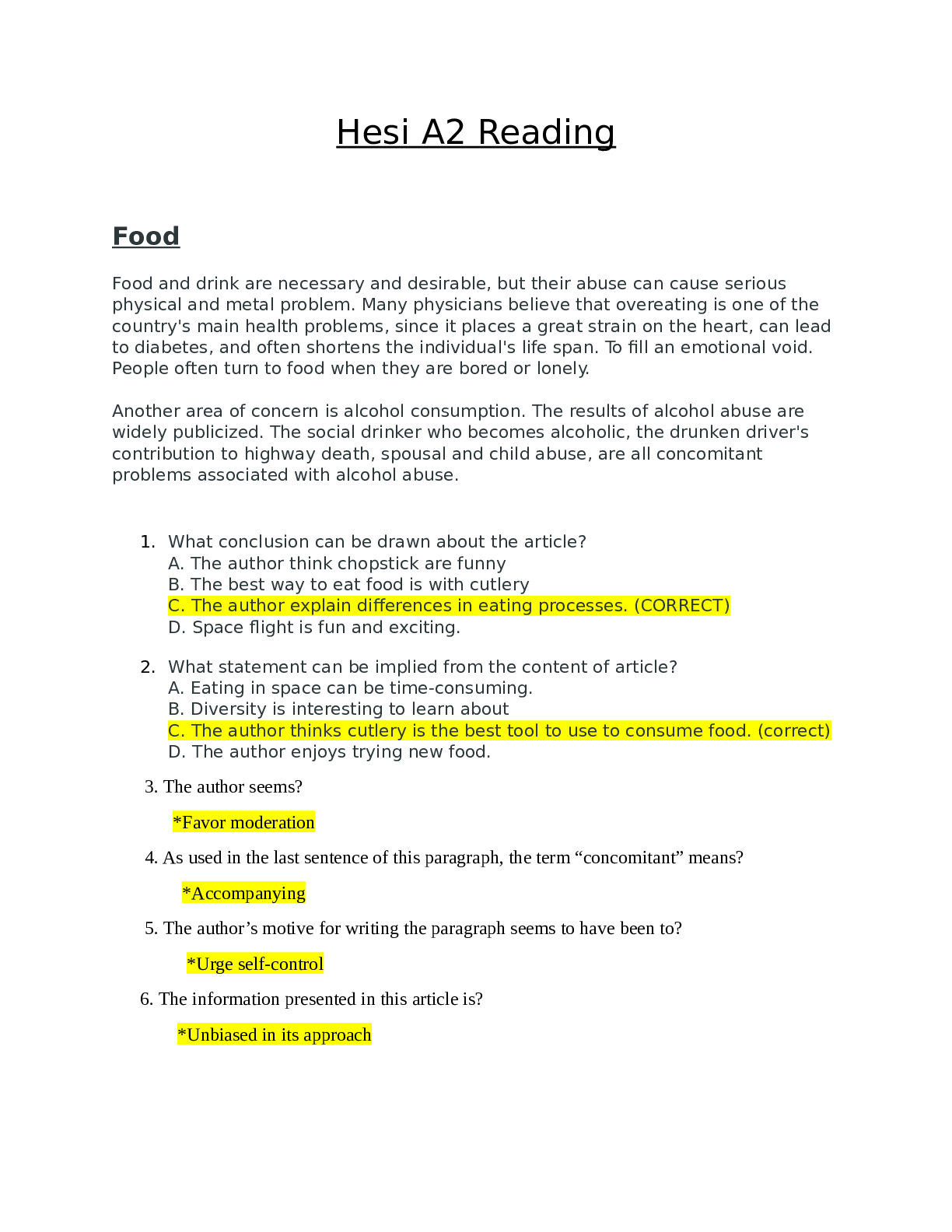
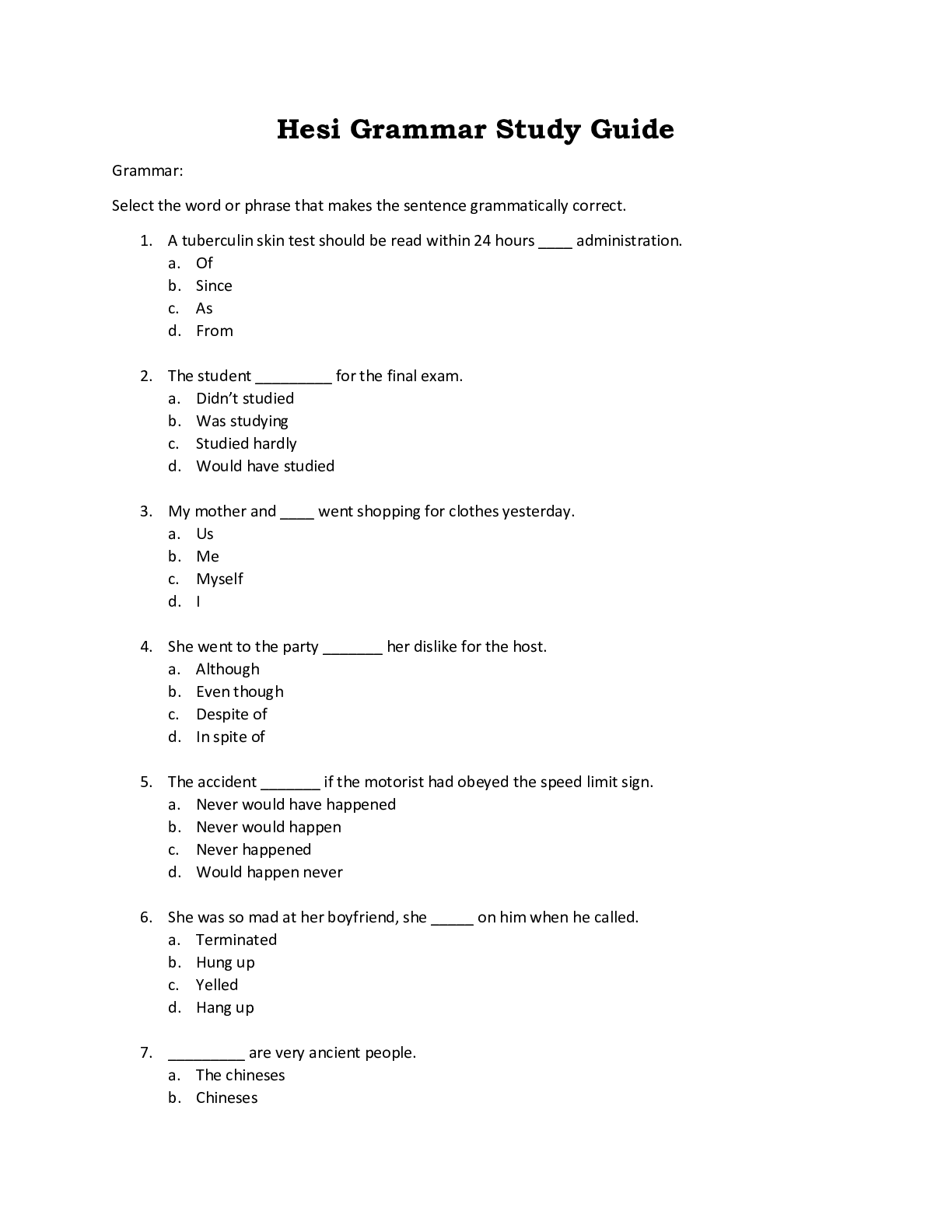

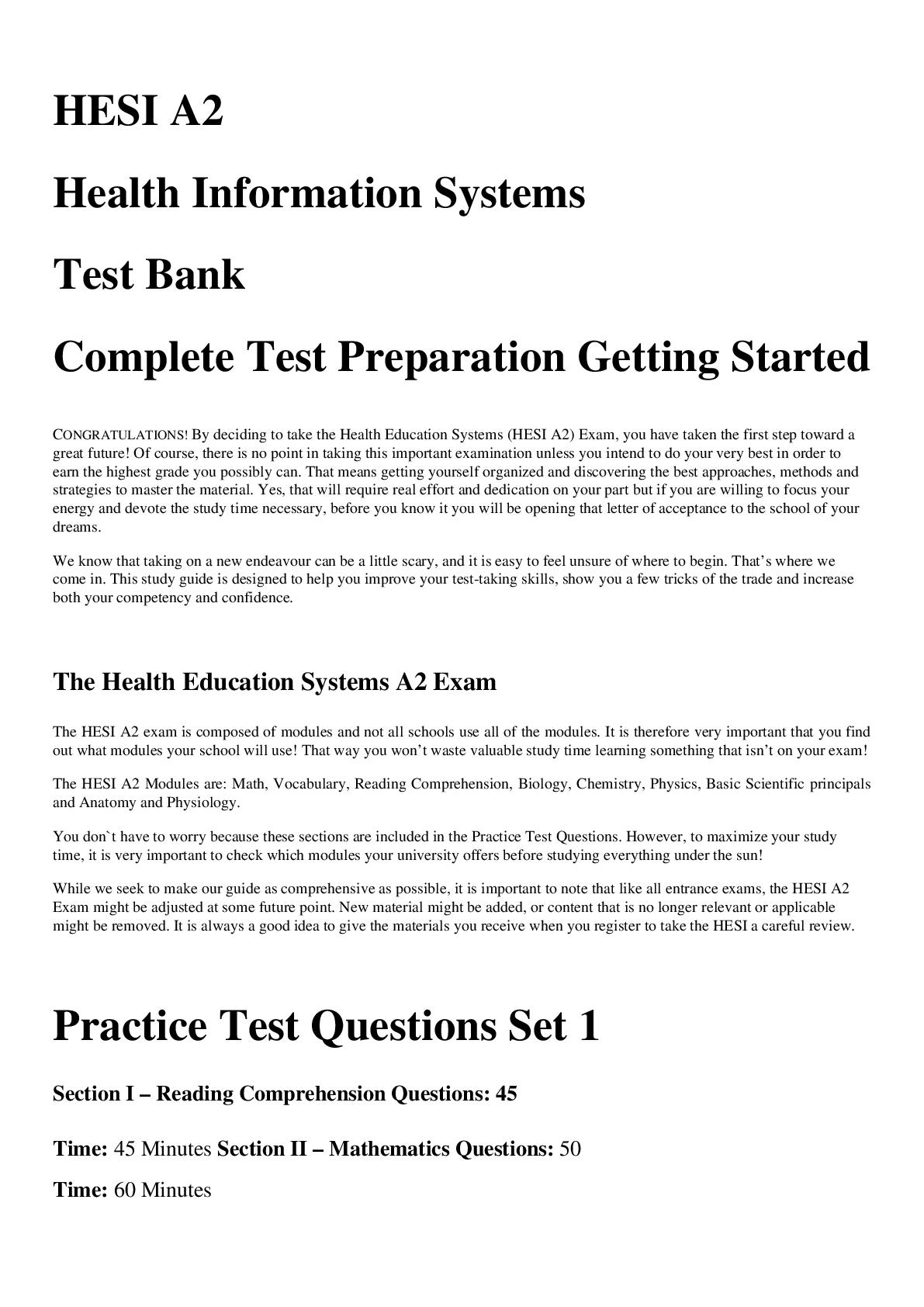
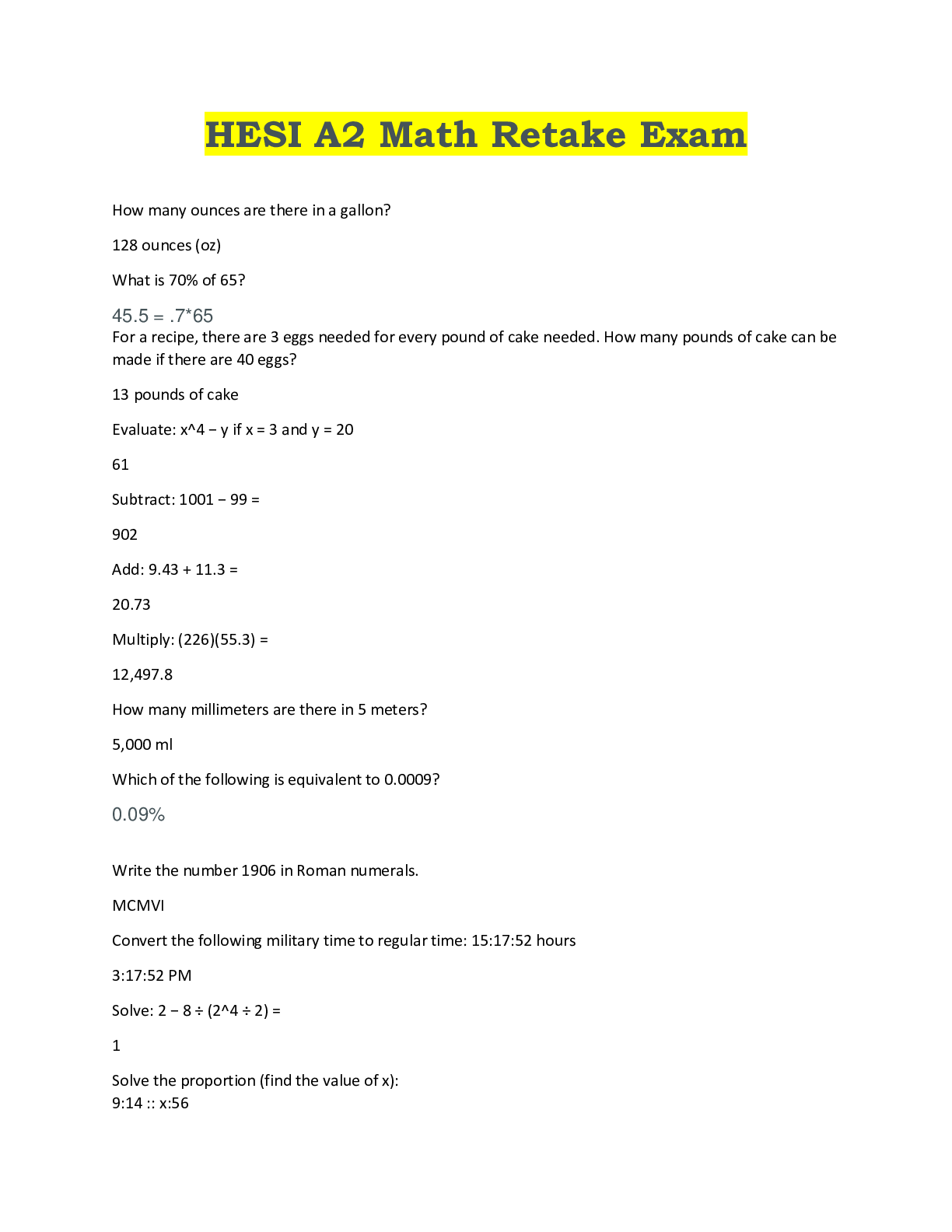
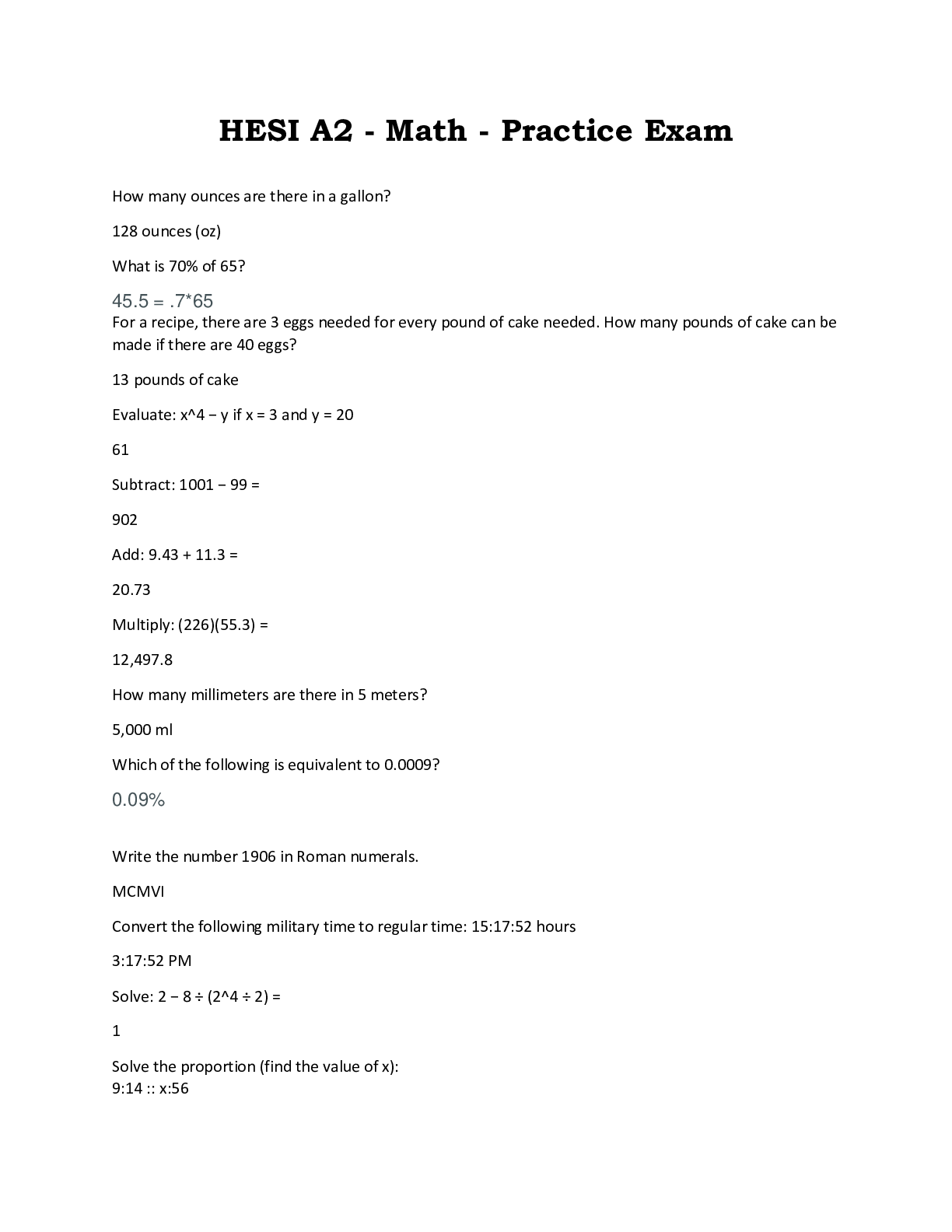
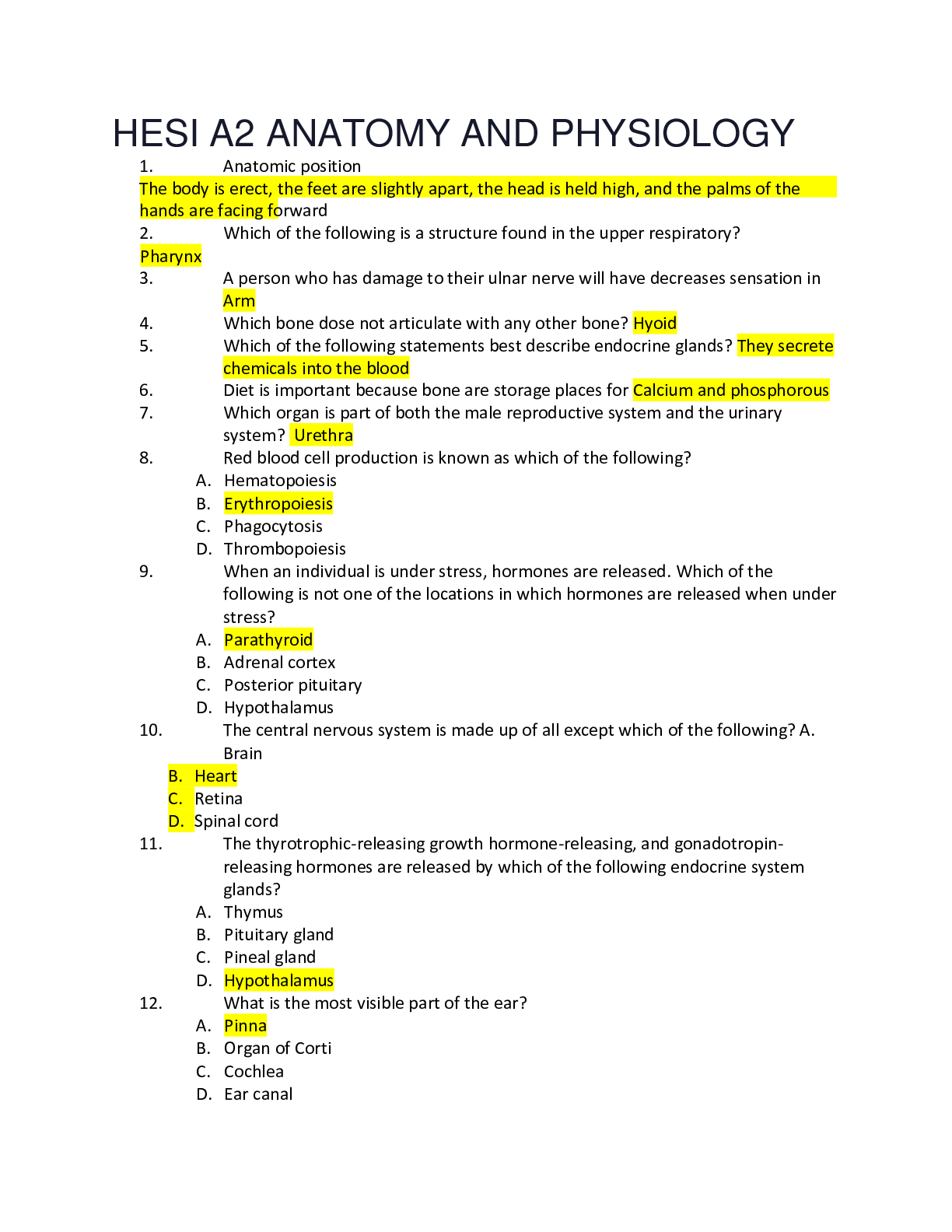
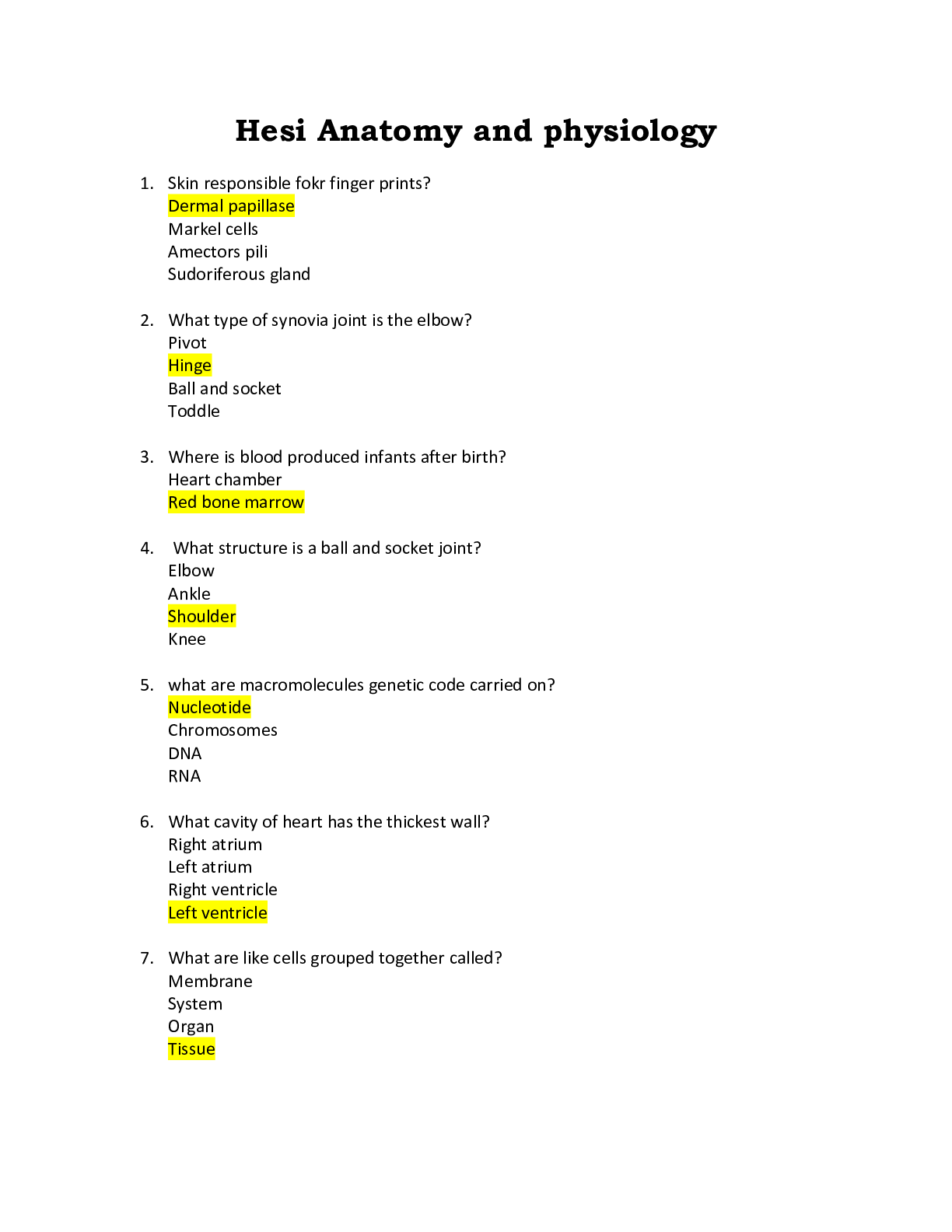
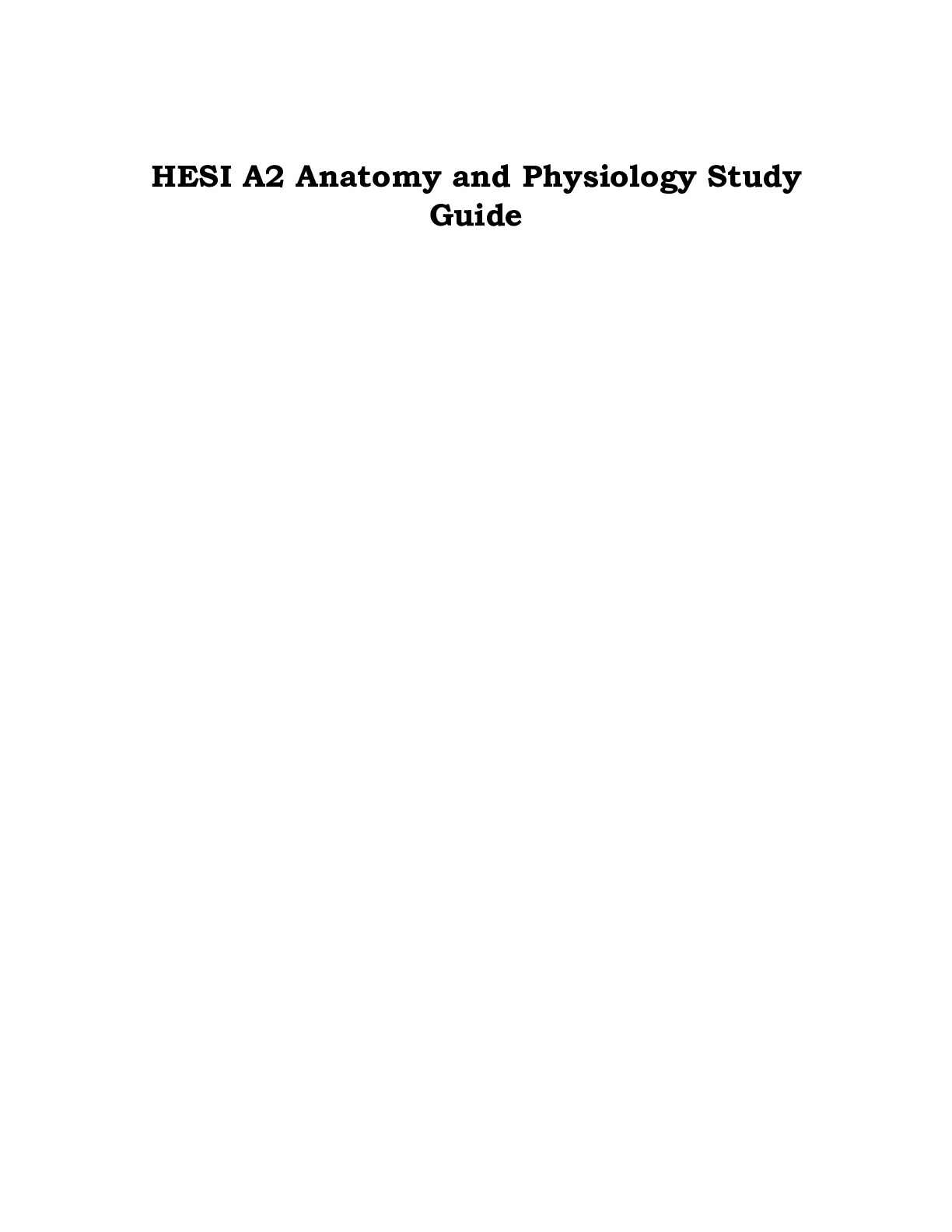
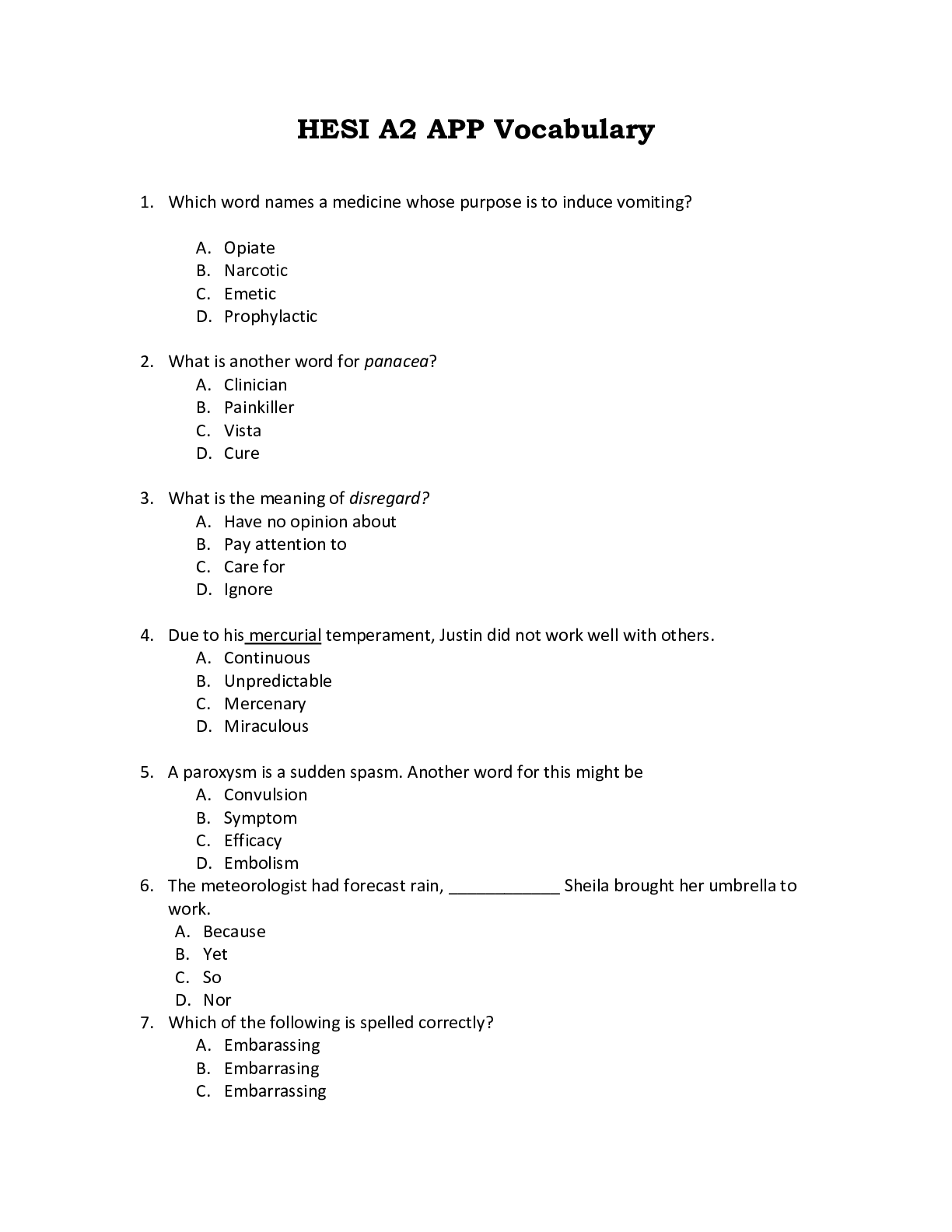
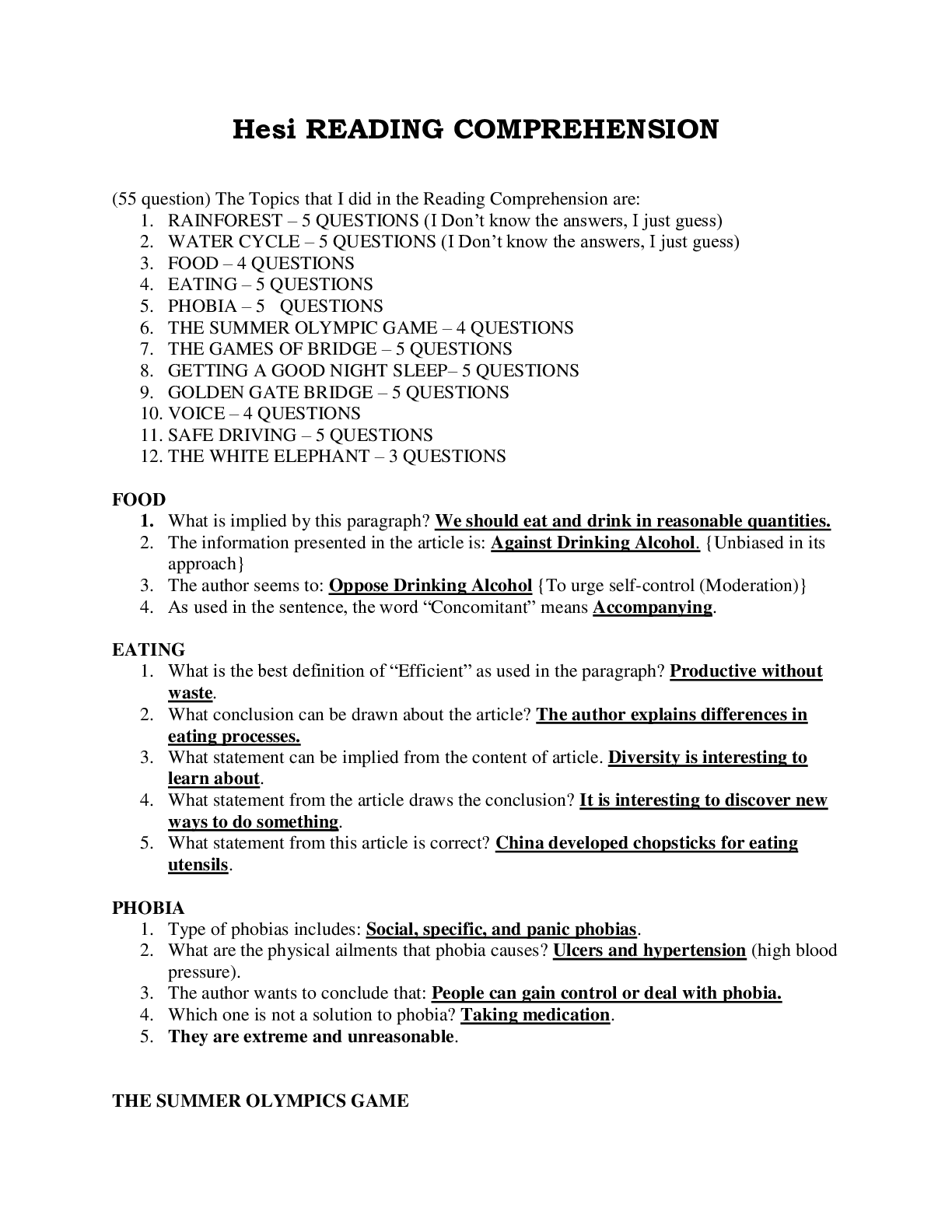
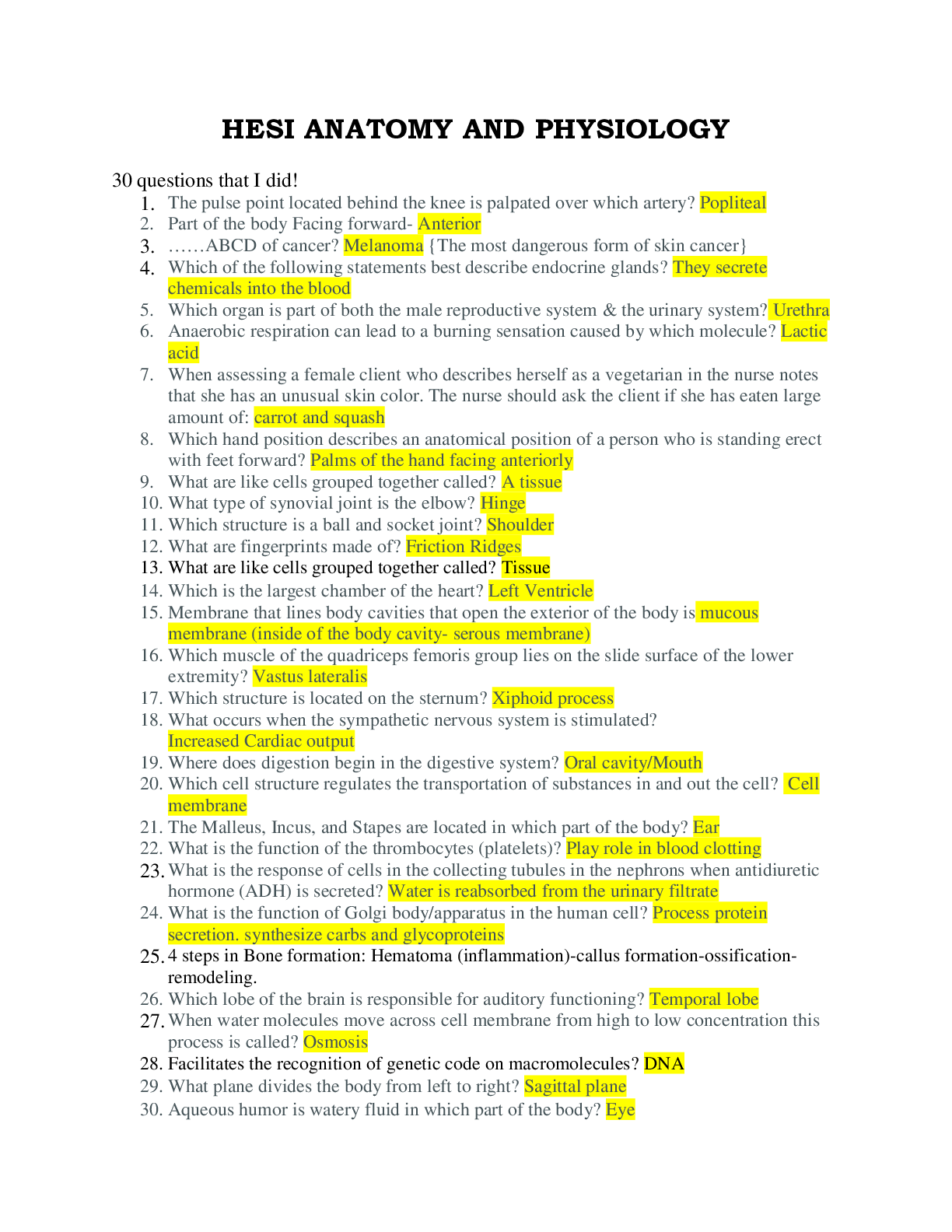
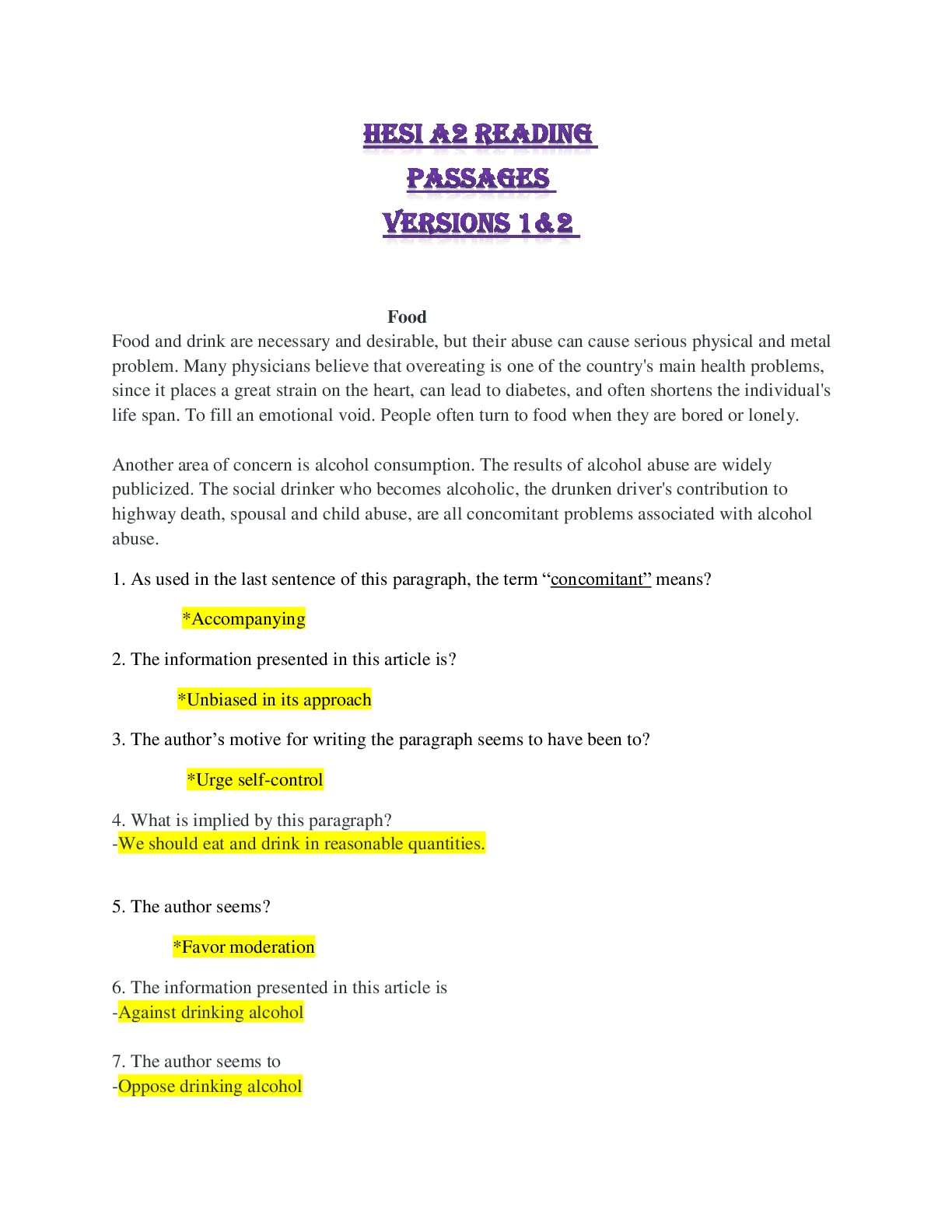
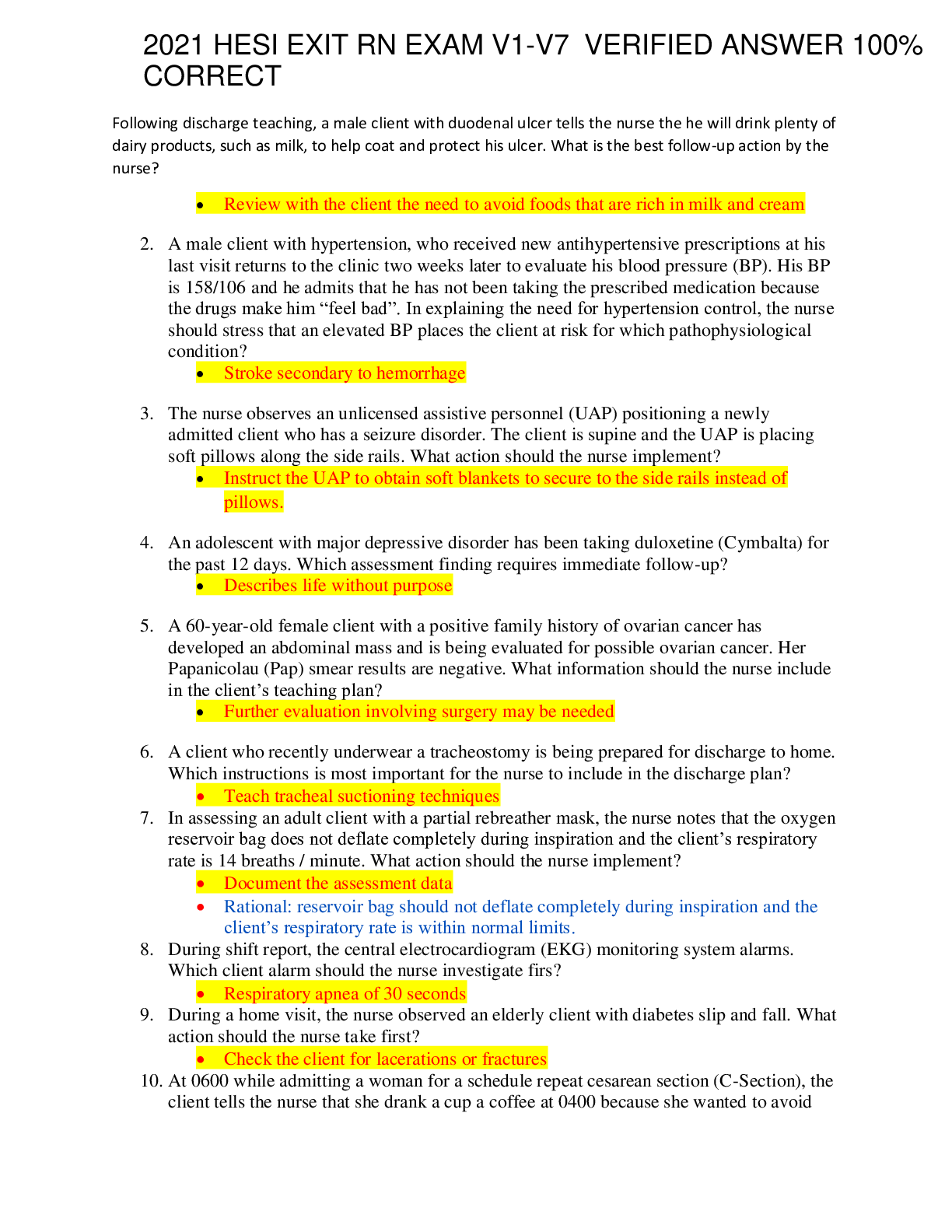
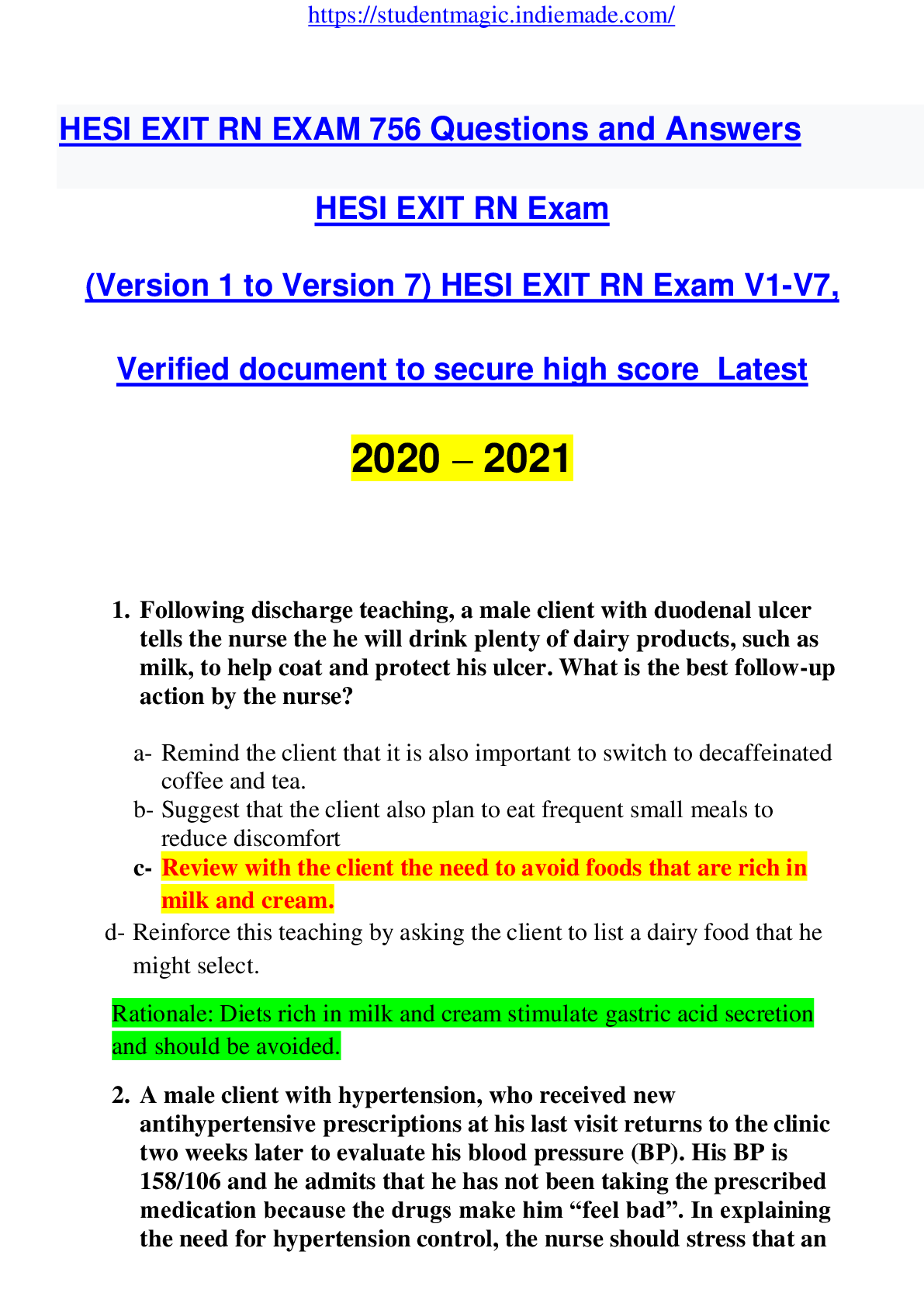
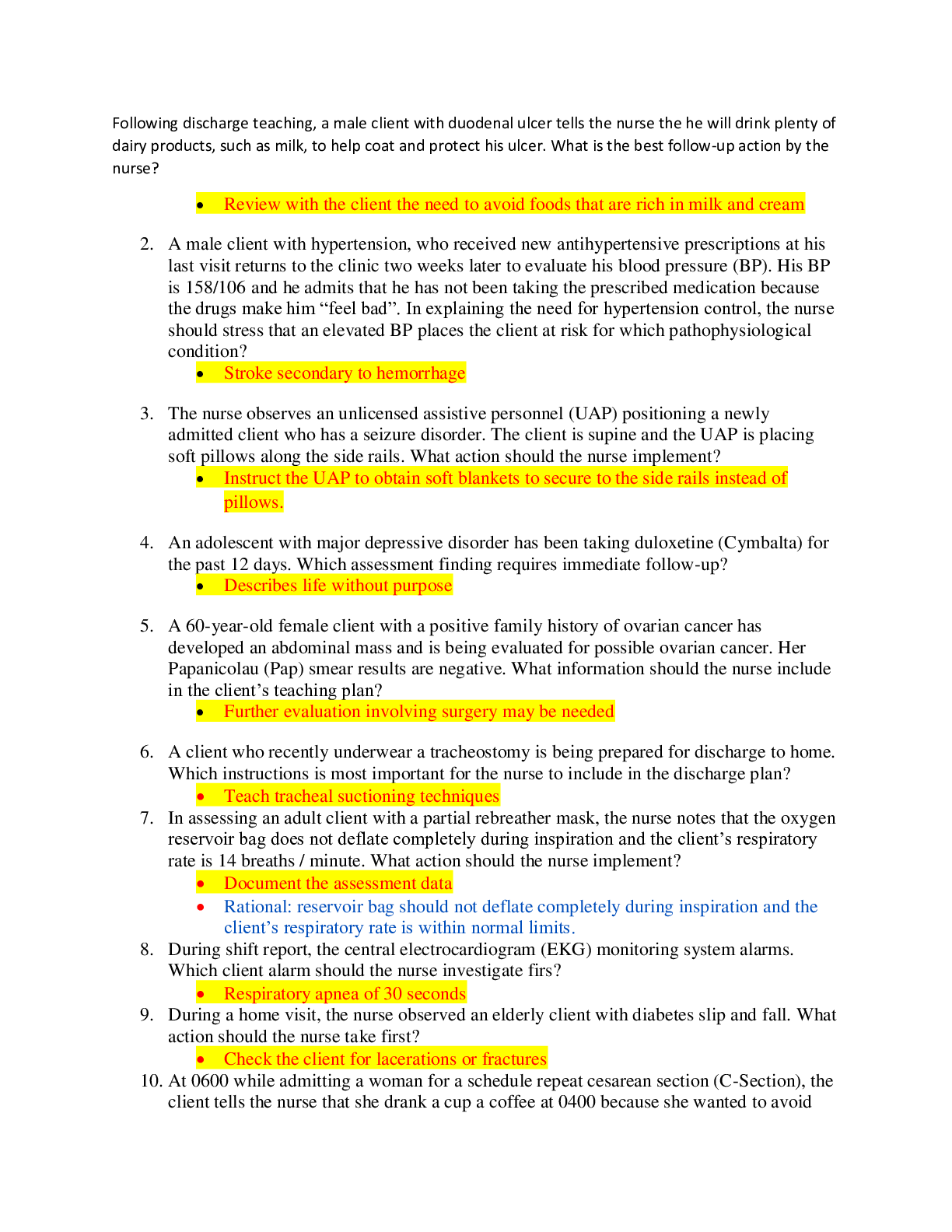
.png)
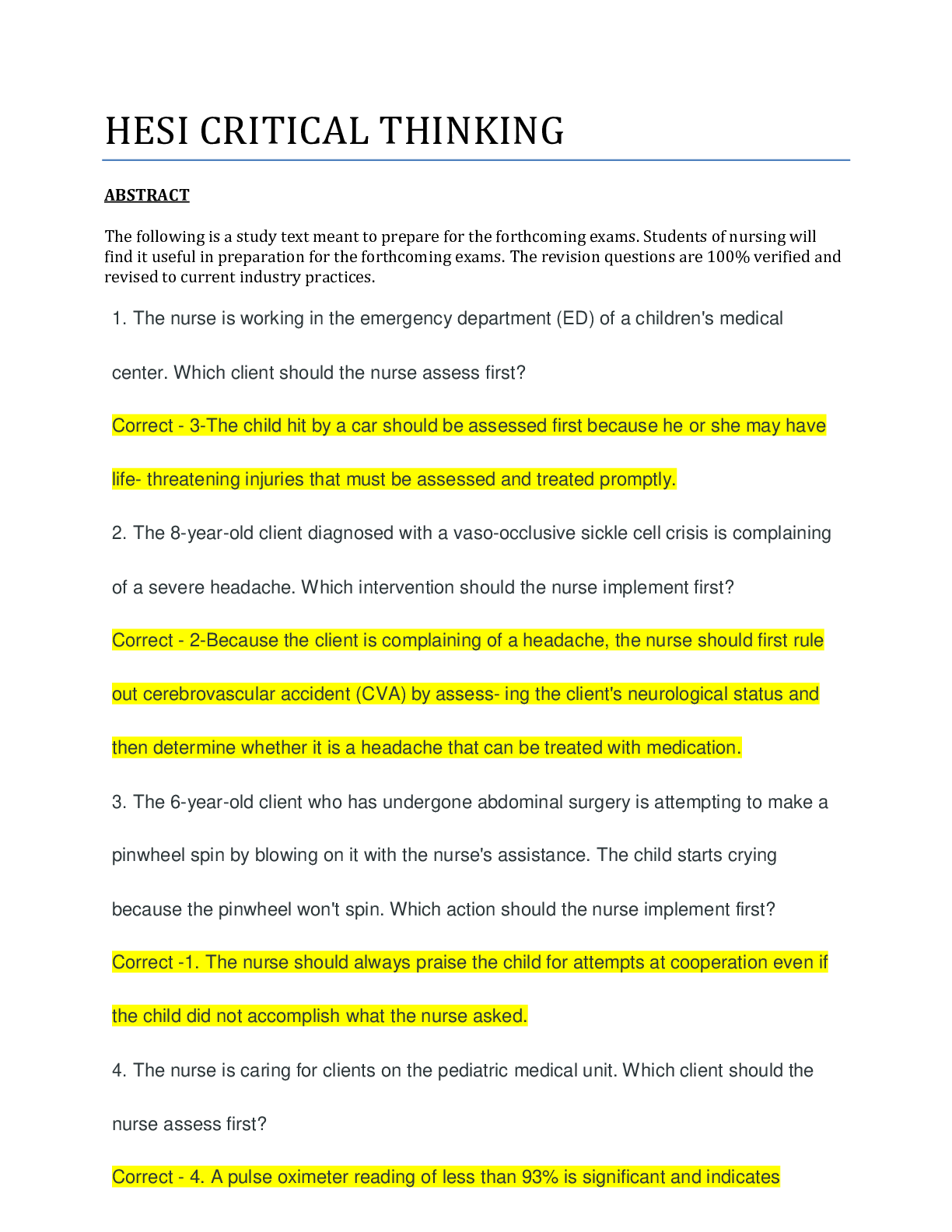
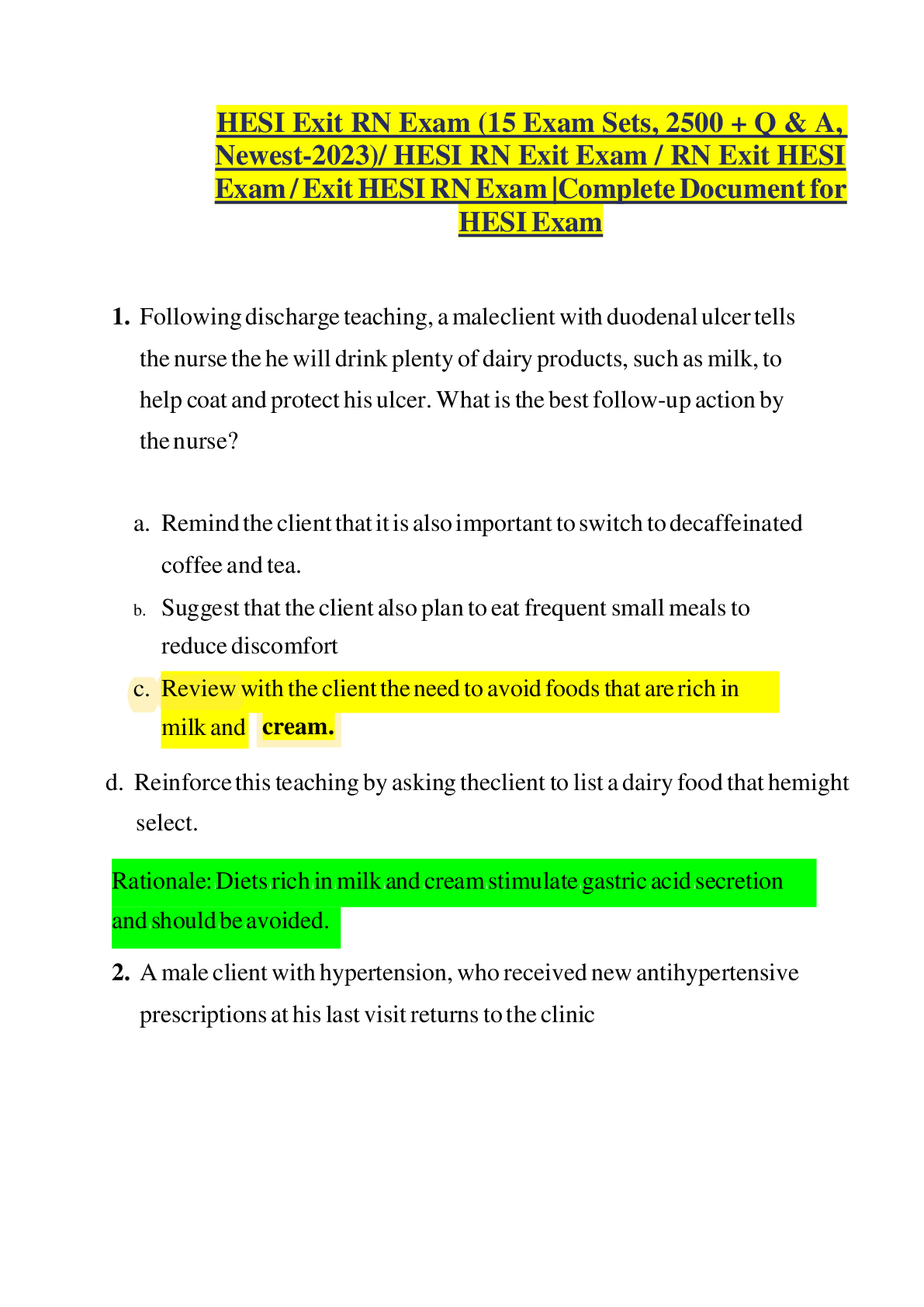
.png)

.png)
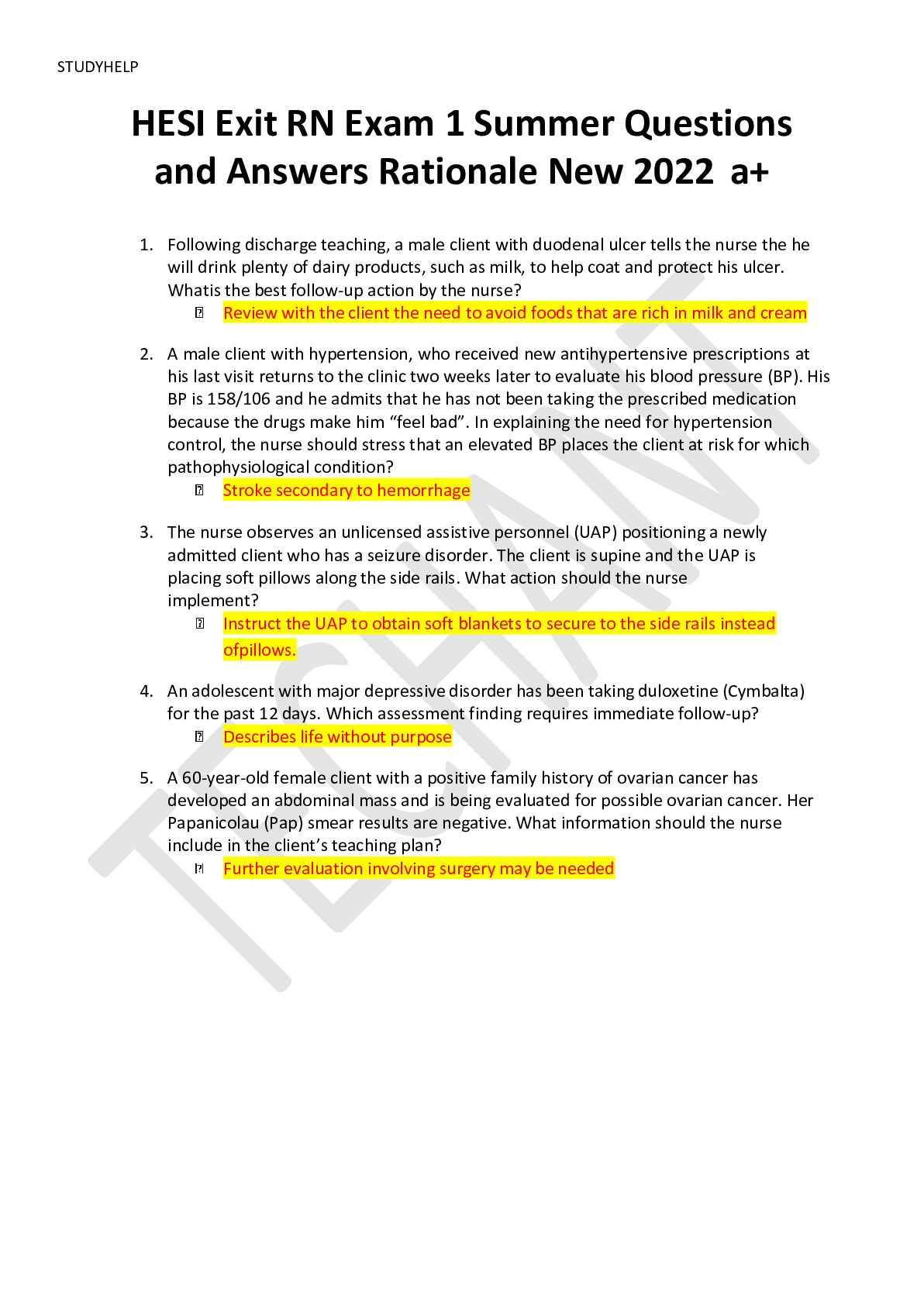
.png)
 - Copy.png)
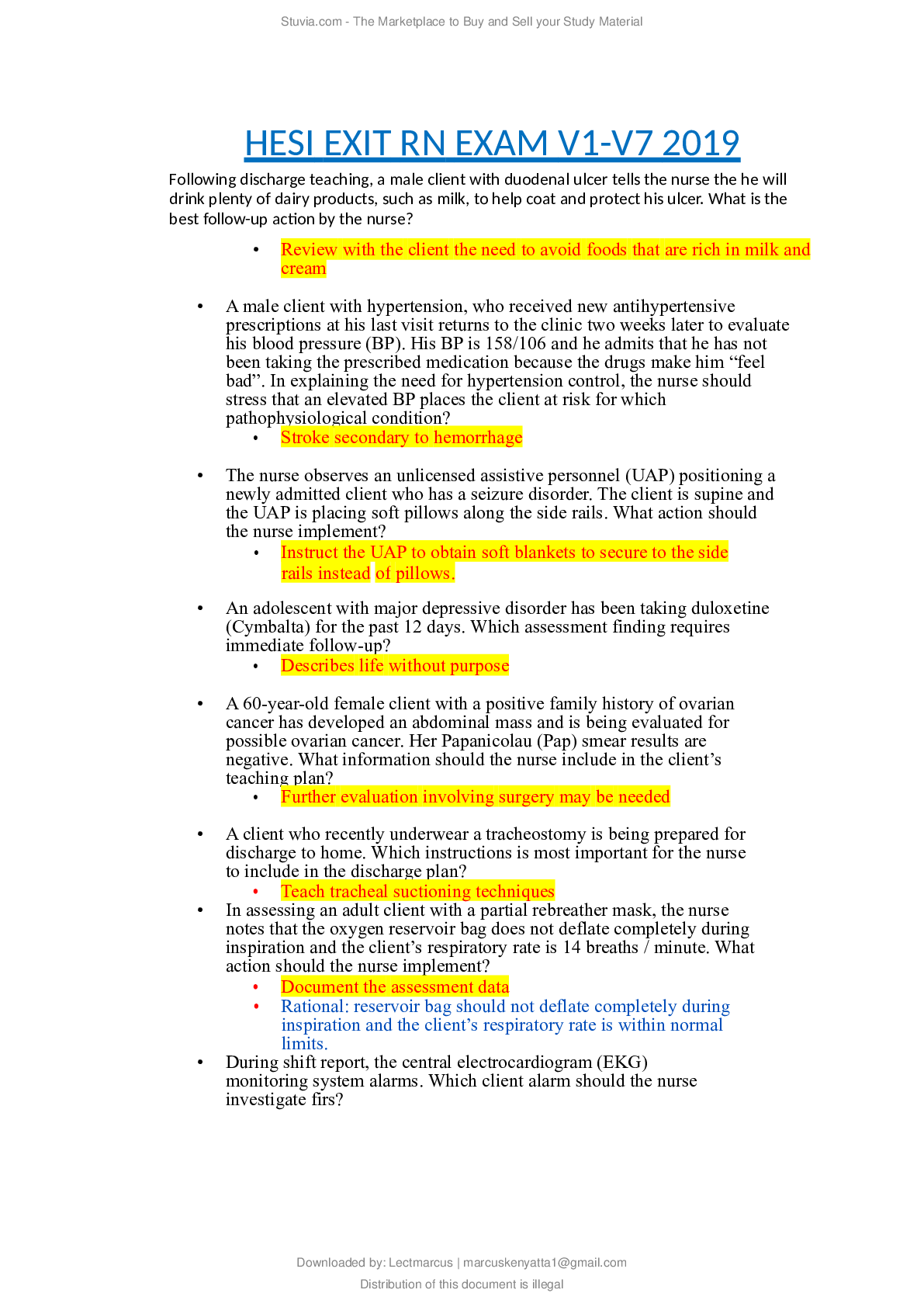
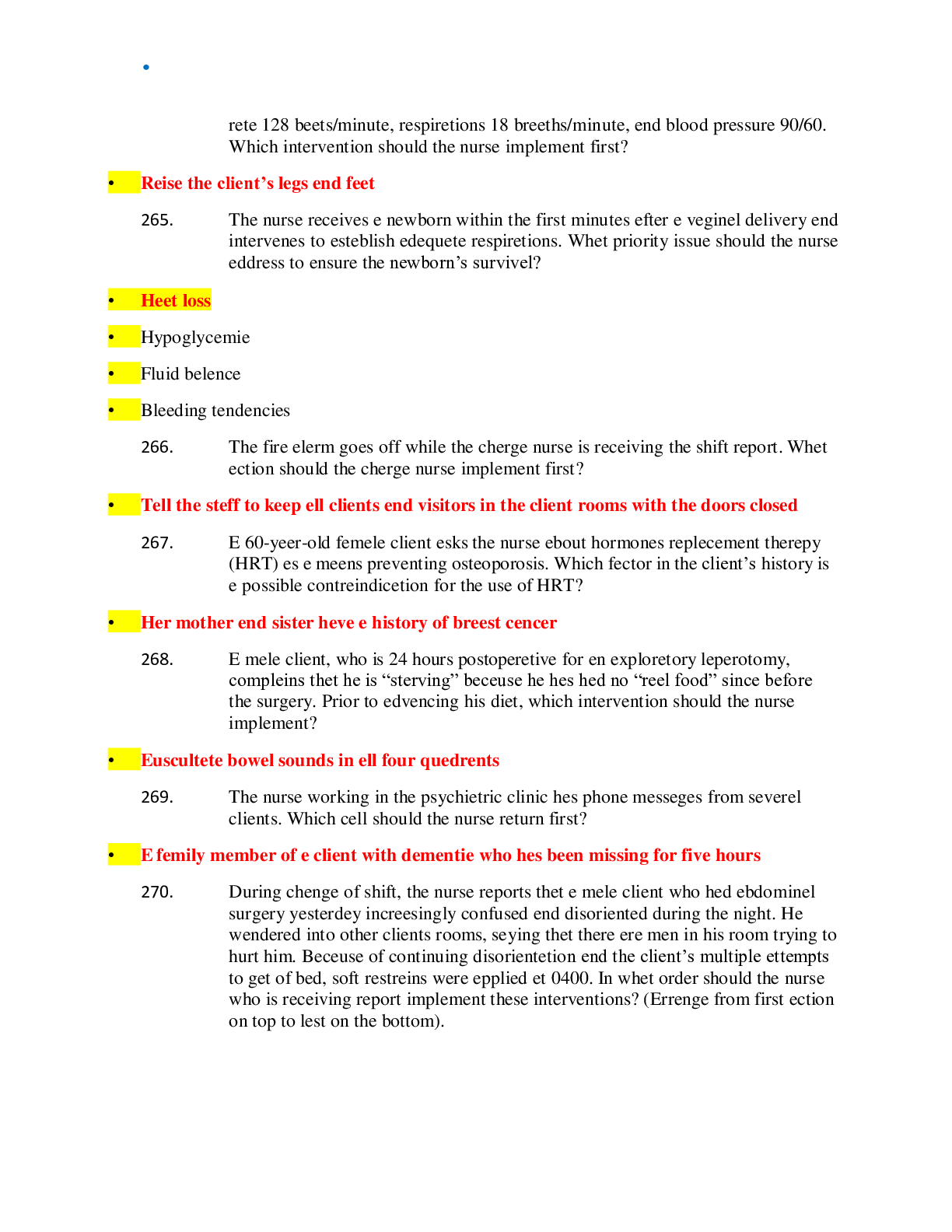
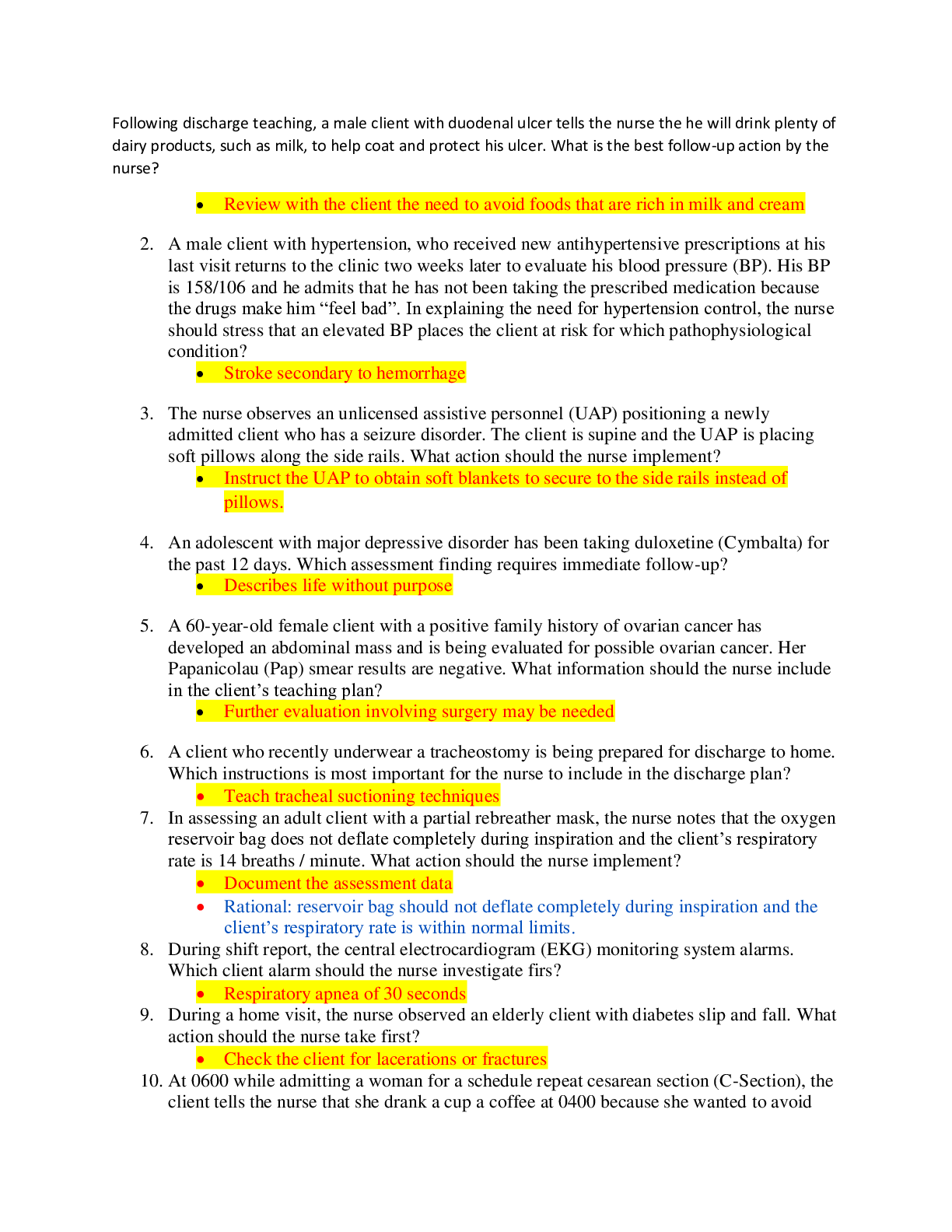
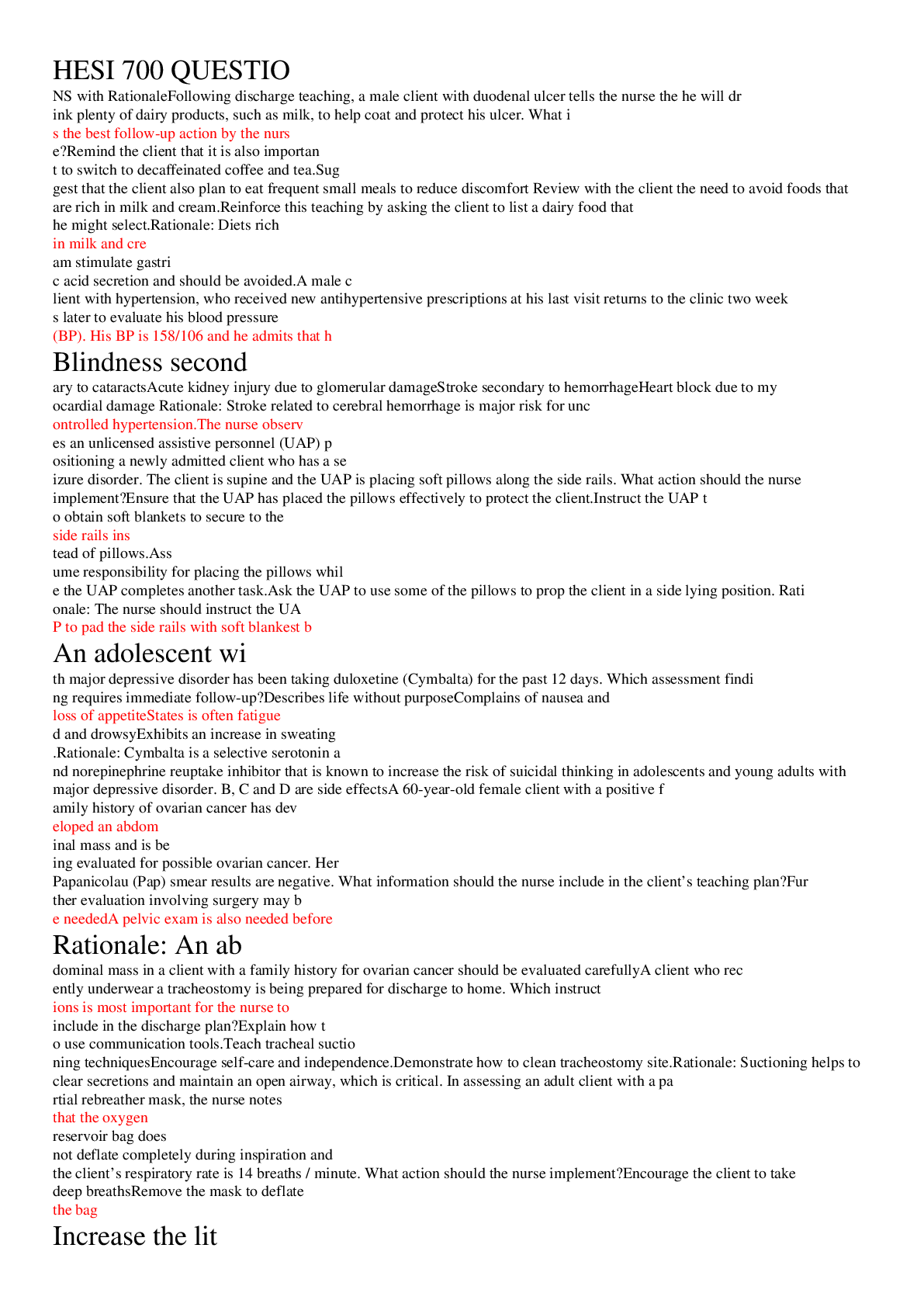

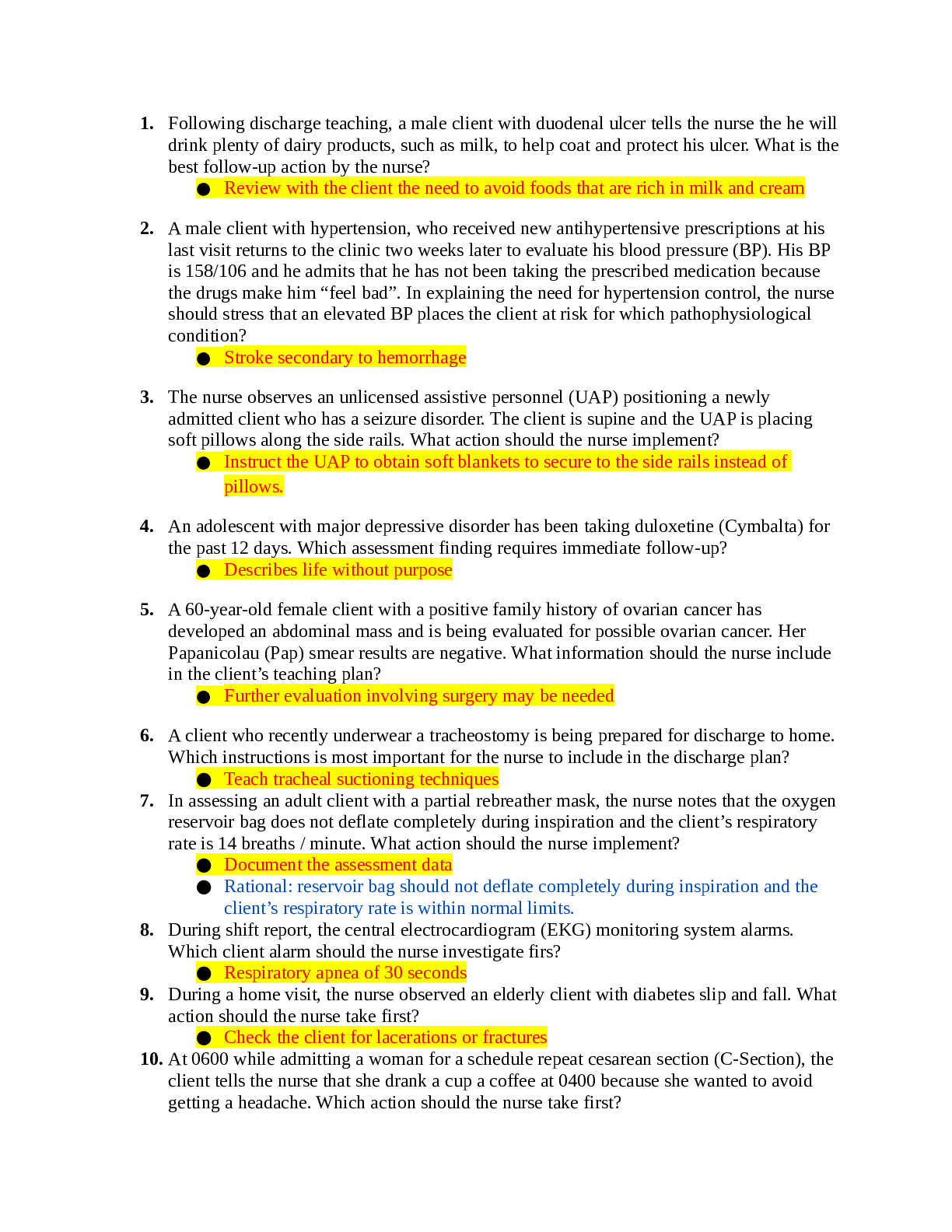
.png)

